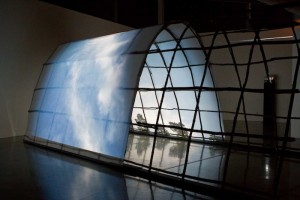| OFFERINGS is a collaborative artwork that proposes a reflection on the meaning of offering. Integrating contemporary and traditional elements, the piece uses new media in its creation, form and presentation. Based on a relational aesthetic, it encourages the interpretation of practices from different cultures. In many Aboriginal cultures, offerings are gestures filled with spiritual, social and political meaning. We offer a meal, a feast to the members of the community or to visitors. We offer stories. We offer songs to the plants we harvest and to animals that feed us. We offer tobacco to elders, to spirits. Offerings were at the heart of the exchanges that took place at the time of contact with Europeans. We offered refuge. We offered knowledge of the territory. We offered medicine. We offered to share the land. Rituals of offering are also present in many different cultures. Offerings are based in the logic of giving without a time frame and self-interest. It can take the shape of rituals or ceremonies. It sometimes constitutes a private gesture. With OFFERINGS, my intention is to create a gathering space and engage the public in a collective investigation of the complex and diverse practices linked to this human gesture. This web site is part of a travelling exhibition. For more information please contact France at francetr@telus.net. |
OFFRANDES est une œuvre collaborative qui propose une réflexion sur le sens du don. Intégrant des éléments contemporains et traditionnels, elle fait l’usage des nouveaux médias dans sa création, sa forme et sa présentation. Basée sur une esthétique relationnelle, elle incite à l’interprétation de pratiques issues de diverses cultures. Dans plusieurs cultures autochtones l’offrande constitue un geste chargé de sens sur le plan spirituel, social et politique. On offre un repas, un festin aux membres de sa communauté ou aux visiteurs. On offre des histoires. On offre des chansons aux plantes et aux animaux qui nous nourrissent. On offre du tabac aux aînés, aux esprits. L’offrande fut au cœur des échanges au moment du contact avec les Européens. On a offert refuge. On a offert la connaissance du territoire. On a offert les plantes médicinales. On a offert la terre en partage. L’offrande est également présente dans plusieurs autres cultures. Elle s’inscrit souvent dans une logique de dons désintéressés et intemporels. Elle peut prendre la forme de rituels ou de cérémonies. Elle constitue parfois un geste privé. Avec OFFRANDES, mon intention est de créer un espace de rencontre et d’engager le public dans une réflexion collective sur la complexité et la diversité des pratiques liées au geste d’offrir. Ce site fait partie d’une exposition itinérante. Pour plus d’information, contactez France à francetr@telus.net |





